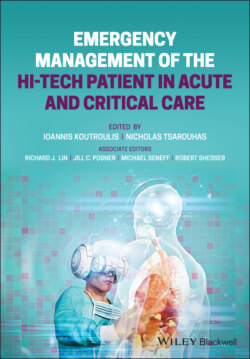Читать книгу Emergency Management of the Hi-Tech Patient in Acute and Critical Care - Группа авторов - Страница 38
Buried Bumper Syndrome
ОглавлениеBuried bumper syndrome (BBS) is a rare but life‐threatening complication of children with G‐tubes. BBS is defined as the presence of an embedded internal fixation device into the gastric mucosa of the abdominal wall. This is typically caused by securing the external retention device too tightly to the skin surface and thus narrowing the space between the internal and external retention devices and pressing the internal device into the gastric mucosa. Rates of BBS in adults average 1% but can be as high as 5% in pediatric patients. This is seen with both internal balloons and rigid retention devices, but it is more common with the latter. Risk factors for BBS include pediatric age, jejunal extension from the G‐tube, multiple G‐tube placements, and improper home care. Pediatric patients are at a higher risk because of their expected weight gain and compression against the external bolster. Those with GJ tubes are at higher risk because the weight of jejunal extensions is thought to pull the internal bolsters out of their perpendicular placement and cause unequal pressure on the stomach wall. Finally, repeat G‐tube replacements can increase the inflammatory reaction in the stomach wall and thus encourage tissue growth around the internal retention device.
Figure 1.5 Radiograph of a G‐tube dye study shows dye within the small intestine only. This image is consistent with a gastric outlet obstruction whereby the balloon is located in the pylorus blocking dye from filling the stomach.
Patients can be asymptomatic and simply present with inability to feed through the tube. The classic triad for BBS is inability to insert the G‐tube further into the stomach, loss of tube patency (unable to feed or draw back from tubing), and leakage around the tube site. BBS can be complicated by GI bleeding, perforation, and peritonitis, which can be fatal.
BBS is diagnosed by endoscopy. However, abdominal ultrasound and computerized tomography (CT) scan can help identify bumper location if it is not apparent on endoscopy. Depending on the extent of the internal bumper's migration through the gastric mucosa, the bumper may be removed either endoscopically or surgically. Bumpers that have passed through the lamina muscularis propria and are located between the stomach and abdominal wall will need surgical removal.
